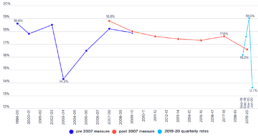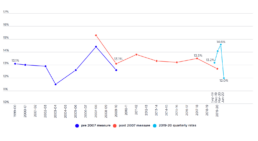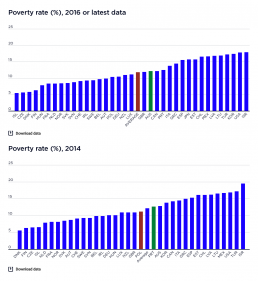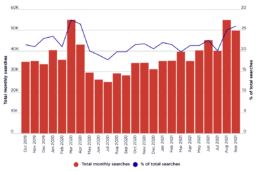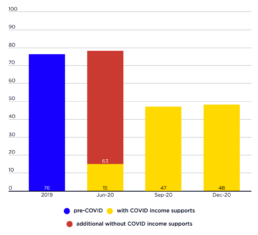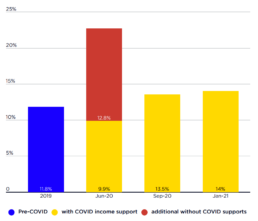Poverty gaps
This graph shows the average poverty gap for all households in poverty from 1999 to 2019. It is in 2019 dollars, and using the 50% median income after-housing costs poverty line.
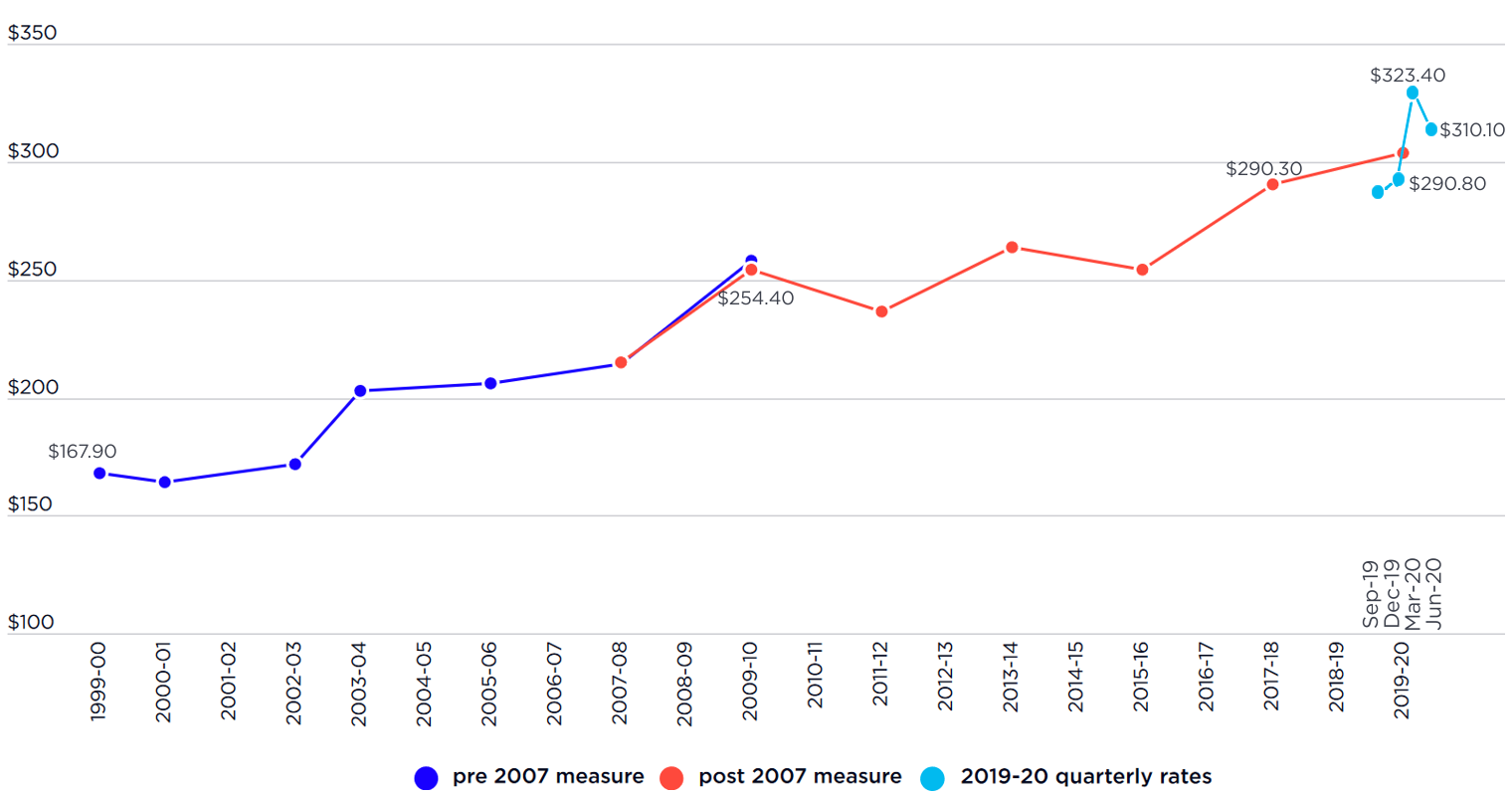 The higher (red) line shows poverty gaps measured using the pre-2007 ABS income definition, while the lower (dark blue) line is based on the post 2007 income definition. The light blue line shows the quarterly changes in the poverty gap during the 2019-20 period.
The average poverty gap increased steadily from $168 per week in 1999 to $254 per week in 2009 (in constant 2019 values), then rose to $290 per week in 2017. Over that period the poverty gap followed a different pattern to the poverty rates during the same period, reflecting a combination of factors working against each other:
* Changes in…
The higher (red) line shows poverty gaps measured using the pre-2007 ABS income definition, while the lower (dark blue) line is based on the post 2007 income definition. The light blue line shows the quarterly changes in the poverty gap during the 2019-20 period.
The average poverty gap increased steadily from $168 per week in 1999 to $254 per week in 2009 (in constant 2019 values), then rose to $290 per week in 2017. Over that period the poverty gap followed a different pattern to the poverty rates during the same period, reflecting a combination of factors working against each other:
* Changes in…
Percentage of children in poverty from 1999-2019
This graph shows the percentage of children in poverty from 1999 - 2019, using the 50% of median income after-housing costs poverty line.
The poverty line used is 50% of median income, taking account of housing costs. The lower (dark blue) line shows poverty rates measured using the pre-2007 ABS income definition, while the higher (red) line is based on the post 2007 income definition. The light blue line shows the quarterly changes in poverty rates during the 2019-20 period.
It shows that child poverty, alongside the overall poverty rates, declined substantially from 1999 to 2003 (from 18.6% to 14.3%), then rose to 18.8% in 2007. It fell gradually to 17.6% in 2017.
It also shows that child poverty rose sharply than fell dramatically during the first year of the pandemic (2019-20); from 16.2% in the September quarter of 2019 to 19% in the March quarter of 2020, then fell to 13.7%, a two-decade low, in June 2020.
Poverty lines by family type
This table shows poverty lines by family type in dollars per week, including social security payments.
Percentage of all people in poverty from 1999 - 2019
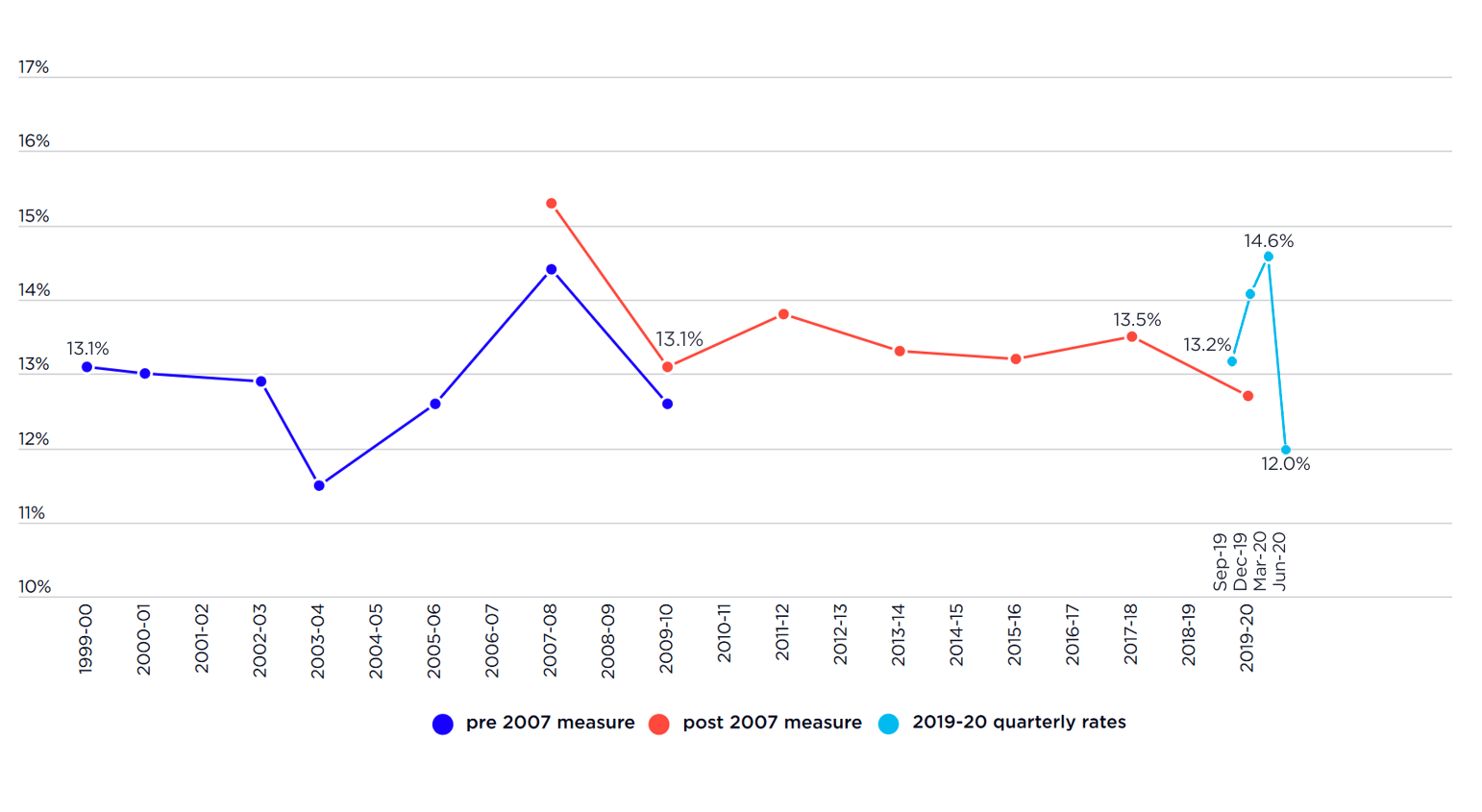 This graph shows the percentage of all people in Australia in poverty from 1999 - 2019. The poverty line used is 50% of median income, taking account of housing costs. The lower (dark blue) line shows poverty rates measured using the pre-2007 ABS income definition, while the higher (red) line is based on the post 2007 income definition. The light blue line shows the quarterly changes in poverty rates during the 2019-20 period, when the impacts of COVID-19 lifted the poverty rate from 13.2% in the September quarter of 2019 to 14.6% in the March quarter of 2020, and the extra coronavirus income support payments introduced meant it fell to 12% - a 17 year low - in the June quarter of 2020.
This graph shows the percentage of all people in Australia in poverty from 1999 - 2019. The poverty line used is 50% of median income, taking account of housing costs. The lower (dark blue) line shows poverty rates measured using the pre-2007 ABS income definition, while the higher (red) line is based on the post 2007 income definition. The light blue line shows the quarterly changes in poverty rates during the 2019-20 period, when the impacts of COVID-19 lifted the poverty rate from 13.2% in the September quarter of 2019 to 14.6% in the March quarter of 2020, and the extra coronavirus income support payments introduced meant it fell to 12% - a 17 year low - in the June quarter of 2020.
One in eight people in Australia are living in poverty
One in eight people in Australia, including one in six children are living in poverty, a new report released on the eve of Anti-Poverty Week has found, as cost of living pressures continue to put households under strain. As many as 13.4 per cent of the population (or 3.3 million people) and 16.6 per cent of children (or 761,000 kids) were living below the poverty line in the first year of the pandemic (2019-20), according to the Poverty In Australia 2022 report by the Australian Council of Social Service and UNSW Sydney, using the latest available data from the ABS. The study also revealed people in poverty are falling further behind the rest of society, with their average weekly incomes dropping to $304 below the poverty line. The report found that temporary income supports introduced during COVID lockdowns in 2020 – the Coronavirus Supplement and Economic Support Payment - pulled 646,000 people, including 245,000 children, above the poverty line. Those new supports almost doubled…
Poverty rates in OECD countries
Although the Organisation for Economic and Social Development (OECD) uses the 50% median income poverty line, differences in research methodology mean that the results are close to but not identical to those reported in this website for Australia. 2021 or latest data This graph shows poverty rates among the Organisation for Economic and Social Development (OECD) countries in 2021 (or latest data), using the 50% median income poverty line. The OECD’s estimate for the overall rate of poverty in Australia according to this graph is 12.6% (compared with our estimate for 2019-20 of 13.4%). This makes Australia’s poverty rate the 15th highest among the 38 OECD countries. 2017-18 This graph shows poverty rates among the Organisation for Economic and Social Development (OECD) countries in 2016, using the 50% median income poverty line. The OECD’s estimate for the overall rate of poverty in Australia according to this graph is 12.1% (compared with our estimate for 2017-18 of 13.6%). This…
Percentage of people receiving JobKeeper and COVID Supplements by household income groups
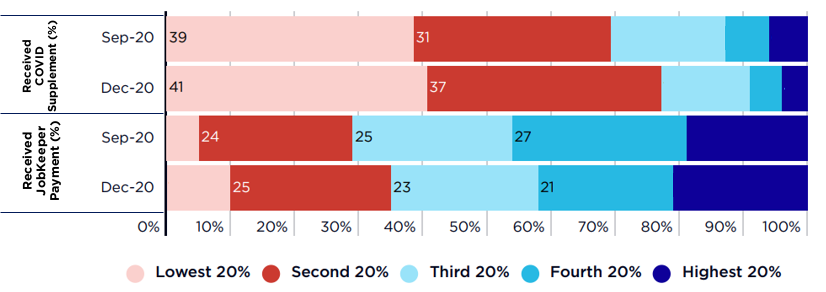 This figure shows shows how COVID income support payments were distributed among households ranked by income in 2020.
JobKeeper Payment mainly lifted the incomes of middle income-households at risk of losing their jobs, and Coronavirus Supplement lifted the incomes of low-income households on income support payments.
Towards the end of the recession in September 2020:
* Around three quarters (76%) of JobKeeper Payments went to the middle 60%;
* A similar proportion of the Coronavirus Supplement (70%) went to the lowest 40%.
* The highest 20% received just 19% of the value of JobKeeper Payment and 6% of that of Coronavirus Supplement.
This figure shows shows how COVID income support payments were distributed among households ranked by income in 2020.
JobKeeper Payment mainly lifted the incomes of middle income-households at risk of losing their jobs, and Coronavirus Supplement lifted the incomes of low-income households on income support payments.
Towards the end of the recession in September 2020:
* Around three quarters (76%) of JobKeeper Payments went to the middle 60%;
* A similar proportion of the Coronavirus Supplement (70%) went to the lowest 40%.
* The highest 20% received just 19% of the value of JobKeeper Payment and 6% of that of Coronavirus Supplement.
Internet searches for food assistance from October 2019 to September 2021
This graph shows trends in internet searches for food relief from before the COVID recession in October 2019 to September 2021: It shows similar peaks in searches for food relief at the start of the national lockdown in March 2020 and those in Sydney, Melbourne and Canberra in August 2021, which were experiencing lockdowns at the time. Significantly, demand fell between March and July 2020 as COVID income supports were introduced, and gradually rose through 2021 after they were removed.
Poverty among JobSeeker recipients with and without COVID income supports (% of all people in poverty)
This graph shows that poverty among people on working age income support payments fell sharply in the recession. It shows that poverty among people in households on Jobseeker Payment fell by four-fifths, from 76% in 2019 to 15% in June 2020.
Poverty with and without COVID income supports
These graphs show the number and rate of people in poverty during the COVID recession and early stages of the recovery up to January 2021. They use the 50% of equivalent disposable household income, and the results have been adjusted to take account of housing costs, and shows the difference that the COVID income support payments (mainly Coronavirus Supplement and JobKeeper Payment) made to the number and rate of people in poverty. The graphs show that: * In June 2020, 9.9% of people were below the poverty line, compared with 11.8% in 2019 and 22.7% who would have been in poverty in June 2020 without the new income supports (Figure 8a). * An estimated 2,613,000 people were in poverty in June 2020, well below the 3,018,000 in 2019, and half the number that would have been in poverty (5,772,000) in June 2020 had COVID income supports not been introduced (Figure 8b). This confounds the traditional view on the impact of recessions on incomes - if income support payments sit below the…

